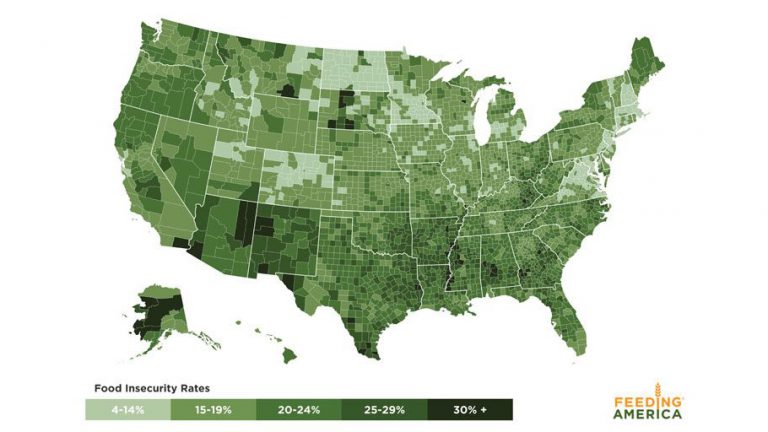URBANA – Before the COVID-19 pandemic, rates of food insecurity were lower than they had been in more than two decades, according to hunger relief nonprofit Feeding America. Now that trend is reversing, and millions more Americans are facing hunger this year due to loss of employment and reduced access to school meals.
Feeding America tracks food insecurity rates across the country using Map the Meal Gap, a data-driven map developed by University of Illinois professor Craig Gunderson.
Using that data, Gunderson recently published a study showing the effects of the pandemic on food insecurity rates around the country. Illinois Newsroom’s Dana Cronin spoke with Gunderson about the study.
This interview has been lightly edited for clarity.
Dana Cronin: Map the Meal Gap is ten years old this year, but you recently put out a study using the map that broke down rates of food insecurity by region. What exactly did you find out?
Craig Gunderson: So, as you might expect is, with COVID, the impacts differ dramatically across the country. And before turning to a discussion about region, I want to emphasize one other key component of this, which is that the main impact of COVID has been on decreasing people’s employment opportunities. And I’m not going to take a position on the wisdom or non-wisdom of lockdowns, but one thing we have to remember is that it’s the most vulnerable amongst us, those who are working in low wage jobs, who have to go to work and no longer can do so. So there’s been a projected 6.6 percentage point increase in unemployment, which is a huge increase in unemployment, given that we were at record low rates of unemployment prior to COVID. But just like the impacts of COVID haven’t been similar across the population, it hasn’t been consistent across regions. So, for example, in parts of the country whereby we have large service sectors, you’re going to find much larger increases in food insecurity than in other areas. An example is something like Clark County, which has Las Vegas in Nevada or Atlantic County, which has Atlantic City, New Jersey, has sharp increases. And there’s a lot of, for that matter, rural areas that are heavily dependent on tourism, and it’s higher. Last summer, they lost out on a lot of business.
DC: And what about here in Illinois? Did you notice any regional differences in food insecurity rates within the state?
CG: There are some sharp disparities across our state over two main dimensions. The first is that many of our southern counties in Illinois have much higher rates of food insecurity, and some of the counties around St. Louis also have higher rates of food insecurity. So that’s the first. Another thing to point out, and I’ve been talking a lot about this recently, is that if you look at Cook County, which has a long history of segregation and racial discrimination, we looked at this and what you see in Chicago, for all those zip codes that are 10 percentage points [of food insecurity] or higher than the average in Cook County, every single one of them is majority Black. Every single one. There’s only a few majority Black zip codes with lower than average food insecurity rates.
DC: What do you think are some of the implications of this study?
CG: The first implication of this is areas that were already hard hit with high rates of food insecurity, continue to see high rates of food insecurity. So in that sense, that hasn’t changed. It’s still the case that Mississippi has the highest rate of food insecurity in the United States. A second implication and something I’ve been saying more and more when I’m giving interviews for different groups, is that the solution to these problems are easy. I mean, we have this incredible program called the Supplemental Nutrition Assistance Program (SNAP), formerly known as the food stamp program. If we were to A. increase the maximum benefit level to individuals and B. expand eligibility to the program, we could see huge reductions in food insecurity across our country. So the one implication for all of us I keep on saying is, is there are some challenges that we face in our society, like finding the vaccine for COVID-19. But there’s an easy solution to food insecurity in our society, [which is] expand SNAP in terms of eligibility and benefit levels. So that’s the implication that they’re talking a lot more about lately. I really think that if we have the will to address food insecure United States, it’s an easy solution.
Dana Cronin is a reporter for Illinois Newsroom. Follow her on Twitter: @DanaHCronin

